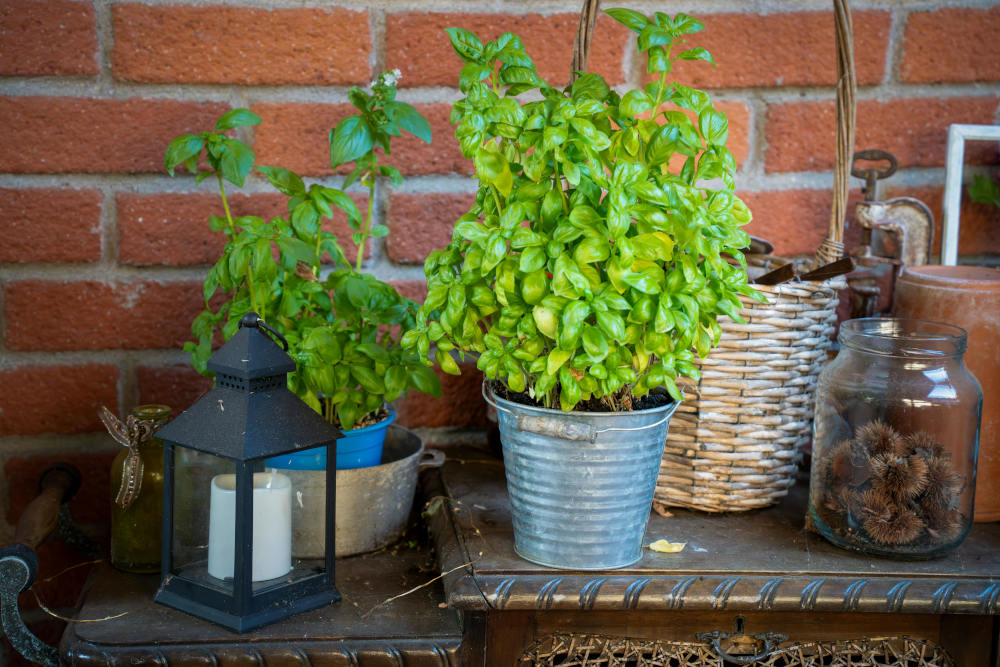
Der Anbau von Kräutern ist einer der lohnendsten Aspekte der Gartenarbeit. Sie sind kompakt, aromatisch und voller gesundheitlicher Vorteile. Doch nicht alle Kräuter sind gute Nachbarn. Genau wie Menschen gedeihen manche Kräuter in der Gesellschaft anderer, während andere miteinander in Konflikt geraten – sie konkurrieren um Ressourcen oder schaden sich sogar gegenseitig durch chemische Wechselwirkungen.
Für einen blühenden Kräutergarten ist es ebenso wichtig zu wissen , welche Kräuter nicht zusammen gepflanzt werden sollten, wie welche nebeneinander gut gedeihen. In diesem Leitfaden untersuchen wir die häufigsten Kräuterkombinationen, warum sie nicht zusammenpassen und wie man einen gesunden, harmonischen Kräutergarten plant.
Panaprium ist unabhängig und wird vom Leser unterstützt. Wenn Sie über unseren Link etwas kaufen, erhalten wir möglicherweise eine Provision. Wenn Sie können, unterstützen Sie uns bitte monatlich. Die Einrichtung dauert weniger als eine Minute und Sie werden jeden Monat einen großen Beitrag leisten. Danke schön!
Warum manche Kräuter nicht gut zusammen wachsen
Es gibt mehrere Gründe, warum Kräuter nicht gedeihen, wenn sie zusammen gepflanzt werden:
1. Unterschiedlicher Wasser- und Sonnenbedarf
Manche Kräuter lieben feuchten Boden und Schatten, während andere volle Sonne und trockene Bedingungen bevorzugen. Die Kombination dieser beiden Faktoren führt dazu, dass eine Pflanze zu viel oder zu wenig von dem bekommt, was sie braucht.
2. Wurzelwettbewerb
Schnell wachsende oder invasive Kräuter können langsamer wachsende Nachbarn überwuchern und ihnen Nährstoffe und Platz rauben.
3. Allelopathie
Einige Kräuter geben aus ihren Wurzeln oder Blättern natürliche Chemikalien ab, die das Wachstum benachbarter Pflanzen hemmen. Dieses Phänomen wird als Allelopathie bezeichnet.
4. Anziehung oder Abwehr von Schädlingen
Bestimmte Kräuter können Schädlinge anlocken, die benachbarte Pflanzen schädigen oder nützliche Insekten abwehren, die sie unterstützen.
Kräuter, die nicht zusammen gepflanzt werden sollten
Hier finden Sie eine Liste häufiger Kräuterunverträglichkeiten mit Erklärungen, damit Sie die Kombination in Ihrem Garten oder in Kübeltöpfen vermeiden können.
❌ Minze (Mentha spp.) + jedes andere Kraut
Warum es nicht funktioniert:
-
Minze ist sehr invasiv und treibt unterirdische Ausläufer, die schnell den gesamten Raum einnehmen.
-
Es verdrängt langsamer wachsende Kräuter im Kampf um Wasser, Nährstoffe und Licht.
Bessere Option:
-
Pflanzen Sie Minze in einen eigenen Topf oder an einen isolierten Ort . Sie kann sogar in Behältern aggressiv sein.
❌ Fenchel (Foeniculum vulgare) + die meisten Kräuter
Warum es nicht funktioniert:
-
Fenchel ist allelopathisch und setzt Verbindungen frei, die das Wachstum benachbarter Pflanzen hemmen .
-
Es kann auch zu einer Kreuzbestäubung mit Dill kommen , was zu einer schlechten Samenqualität führt.
Bessere Option:
-
Ziehen Sie Fenchel in einem separaten Beet oder großen Behälter , weit entfernt von anderen Kräutern.
❌ Raute (Ruta Graveolens) + Basilikum
Warum es nicht funktioniert:
-
Wenn Raute in der Nähe gepflanzt wird, kann sie das Wachstum des Basilikums hemmen.
-
Raute neigt auch dazu, Bestäuber abzuwehren, die Basilikum benötigt.
Bessere Option:
-
Pflanzen Sie Raute und Basilikum in verschiedenen Teilen des Gartens .
❌ Basilikum (Ocimum Basilicum) + Salbei (Salvia Officinalis)
Warum es nicht funktioniert:
-
Basilikum mag feuchte Erde und häufiges Gießen , während Salbei trockene Bedingungen bevorzugt.
-
Ihre Bedürfnisse sind zu unterschiedlich, um auf demselben Boden koexistieren zu können.
Bessere Option:
-
Pflanzen Sie Basilikum zusammen mit Petersilie oder Koriander und Salbei zusammen mit Rosmarin oder Thymian.
❌ Dill (Anethum graveolens) + Kümmel oder Fenchel
Warum es nicht funktioniert:
-
Diese Pflanzen sind eng verwandt und können sich gegenseitig bestäuben , was zu minderwertigen Samen führt.
-
Sie konkurrieren auch um dieselben Ressourcen , was zu Wachstumsstörungen führt.
Bessere Option:
-
Pflanzen Sie Dill stattdessen mit Kräutern wie Koriander oder Petersilie.
❌ Kamille (Matricaria chamomilla) + Minze
Warum es nicht funktioniert:
-
Obwohl beide ähnliche Bedingungen mögen, wird das invasive Wachstum der Minze die Kamille verdrängen .
-
Die starken Wurzeln der Minze können auch die Fähigkeit der Kamille beeinträchtigen, sich richtig zu entwickeln.
Bessere Option:
-
Ziehen Sie Kamille mit Zitronenmelisse oder Lavendel und halten Sie Minze in einem eigenen Topf.
❌ Koriander (Coriandrum sativum) + Rosmarin
Warum es nicht funktioniert:
-
Koriander bevorzugt kühleres Wetter und feuchten Boden , während Rosmarin unter heißen, trockenen Bedingungen gedeiht.
-
Sie haben sehr unterschiedliche Pflegeanforderungen.
Bessere Option:
-
Kombinieren Sie Koriander mit Petersilie oder Kerbel und Rosmarin mit Thymian oder Oregano.
Übersichtstabelle: Unvereinbare Kräuterkombinationen
| Kraut | Sollte NICHT gepflanzt werden mit | Grund |
|---|---|---|
| Minze | Jedes andere Kraut | Invasive Wurzeln überholen andere |
| Fenchel | Basilikum, Koriander, Dill, die meisten Kräuter | Allelopathisch; hemmt das Wachstum |
| Bereuen | Basilikum | Wachstumshemmung |
| Basilikum | Salbei | Widersprüchliche Boden-/Feuchtigkeitsbedürfnisse |
| Dill | Fenchel, Kümmel | Kreuzbestäubung und Wettbewerb |
| Kamille | Minze | Überfüllung durch Minze |
| Koriander | Rosmarin | Gegensätzlicher Temperatur- und Wasserbedarf |
Tipps zur Vermeidung inkompatibler Paarungen
Nachdem Sie nun wissen, welche Kombinationen Sie vermeiden sollten, finden Sie hier praktische Strategien zur Konfliktvermeidung und zur Anlage eines gesunden Kräutergartens.
🌱 Verwenden Sie einzelne Töpfe für aggressive Züchter
-
Pflanzen Sie Minze, Fenchel und Raute in eigene Behälter.
-
Auch in Hochbeeten sollten Sie sie in eingegrabene Töpfe pflanzen, um die Ausbreitung der Wurzeln zu begrenzen.
☀️ Kräuter nach Wachstumsbedingungen gruppieren
Kombinieren Sie Kräuter nach:
-
Sonnenlicht (volle Sonne vs. Halbschatten)
-
Wasser (feucht vs. trocken)
-
Bodenart (reichhaltig vs. sandig)
Beispiel:
-
Rosmarin, Salbei, Thymian und Oregano lieben trockene, sonnige Bedingungen.
-
Basilikum, Petersilie, Koriander und Schnittlauch bevorzugen feuchte, fruchtbare Böden.
🌿 Vermeiden Sie das Mischen von einjährigen und mehrjährigen Pflanzen auf engem Raum
Einjährige Pflanzen wie Basilikum und Koriander wachsen schnell und sterben ab, während mehrjährige Pflanzen wie Thymian und Oregano sich langsam etablieren und bestehen bleiben. Halten Sie sie getrennt, um ein Gedränge oder frühes Absterben in gemeinsamen Behältern zu vermeiden.
🔄 Vorsichtig rotieren und umpflanzen
Einige Kräuter geben chemische Rückstände in den Boden ab. Warten Sie nach der Ernte oder Entfernung allelopathischer Kräuter (wie Fenchel) eine Saison, bevor Sie empfindliche Kräuter an derselben Stelle pflanzen.
So planen Sie einen konfliktfreien Kräutergarten
Hier finden Sie eine Schritt-für-Schritt-Anleitung zum Anlegen eines Kräutergartens im Behälter oder Beet ohne unvereinbare Kombinationen.
Schritt 1: Listen Sie Ihre Lieblingskräuter auf
Beginnen Sie damit, die Kräuter zu identifizieren, mit denen Sie kochen oder die Sie am häufigsten verwenden.
Schritt 2: Gruppieren Sie sie nach wachsenden Präferenzen
| Feuchtigkeitsliebende Kräuter | Trockenliebende Kräuter | Invasive Kräuter (separate Töpfe verwenden) |
|---|---|---|
| Basilikum, Petersilie, Koriander, Schnittlauch | Thymian, Salbei, Rosmarin, Oregano | Minze, Fenchel, Zitronenmelisse |
Schritt 3: Entwerfen Sie Ihr Layout
-
Verwenden Sie Hochbeete oder große Behälter für kompatible Kräuter.
-
Fügen Sie kleinere Töpfe in Behälter für invasive Kräuter ein, wenn Sie sie optisch im selben Pflanzgefäß haben möchten.
-
Sorgen Sie für ausreichend Sonneneinstrahlung und gute Drainage für alle.
Ein Hinweis zur Mischkultur mit Gemüse
Einige Kräuter, die miteinander nicht kompatibel sind, können dennoch großartige Begleiter für Gemüse sein. Zum Beispiel:
-
Basilikum passt gut zu Tomaten.
-
Dill zieht nützliche Insekten an, die Karotten und Gurken unterstützen.
-
Minze ist zwar bei anderen Kräutern problematisch, hält aber Blattläuse und Kohlmotten fern, wenn sie in der Nähe von Blattgemüse (in einem separaten Topf) angebaut wird.
Das bedeutet, dass Sie weiterhin „Unruhestifter“-Kräuter anbauen können – geben Sie ihnen einfach ihren Platz und wählen Sie Ihre Nachbarn mit Bedacht aus.
Fazit: Bewahren Sie den Frieden in Ihrem Kräutergarten
Wie in jeder Gemeinschaft sind manche Kräuter gute Begleiter, andere brauchen etwas Abstand. Wenn Sie wissen, welche Kräuter nicht zusammen gepflanzt werden sollten, vermeiden Sie häufige Fehler, die zu schlechtem Wachstum, geschmacklosen Blättern oder sogar Gartenversagen führen.
Hier ist die goldene Regel:
👉 Wenn ein Kraut schnell wächst, sich aggressiv ausbreitet oder wachstumshemmende Chemikalien freisetzt, geben Sie ihm seinen eigenen Raum.
👉 Wenn zwei Kräuter unterschiedliche Sonnen- oder Wasserbedürfnisse haben, pflanzen Sie sie getrennt.
Wenn Sie dieser Anleitung folgen und Ihre Pflanzen genau beobachten, können Sie einen lebendigen Kräutergarten anlegen, der in Harmonie gedeiht – ob in Töpfen, Blumenkästen oder Hochbeeten.
War dieser Artikel hilfreich für Sie? Bitte teilen Sie uns in den Kommentaren unten mit, was Ihnen gefallen oder nicht gefallen hat.
About the Author: Alex Assoune
Wogegen Wir Kämpfen
Weltweit-Konzerne produzieren in den ärmsten Ländern im Übermaß billige Produkte.
Fabriken mit Sweatshop-ähnlichen Bedingungen, die die Arbeiter unterbezahlt.
Medienkonglomerate, die unethische, nicht nachhaltige Produkte bewerben.
Schlechte Akteure fördern durch unbewusstes Verhalten den übermäßigen Konsum.
- - - -
Zum Glück haben wir unsere Unterstützer, darunter auch Sie.
Panaprium wird von Lesern wie Ihnen finanziert, die sich unserer Mission anschließen möchten, die Welt völlig umweltfreundlich zu gestalten.
Wenn Sie können, unterstützen Sie uns bitte monatlich. Die Einrichtung dauert weniger als eine Minute und Sie werden jeden Monat einen großen Beitrag leisten. Danke schön.































0 Kommentare